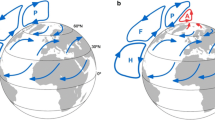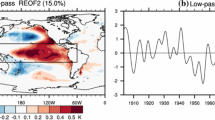Abstract
Nonlinear projections of the Arctic Oscillation (AO) index onto North American winter (December–March) 500-mb geopotential height (Z500) and surface air temperature (SAT) anomalies reveal a pronounced asymmetry in the atmospheric patterns associated with positive and negative phases of the AO. In a linear view, the Z500 anomaly field associated with positive AO resembles a positive North Atlantic Oscillation pattern with statistically significant positive and negative anomalies stretching zonally into central-eastern USA and Canada, respectively, resulting in a cold climate anomaly over northeastern and eastern Canada, Alaska and the west coast of USA, and a warm climate anomaly over the rest of the continent. By contrast, the nonlinear behavior, mainly a quadratic association with AO, which is most apparent when the amplitude of the AO index is large, has the same spatial pattern and sign for both positive and negative values of the index. The nonlinear pattern reveals negative Z500 anomalies over the west coast of USA and the North Atlantic and positive Z500 anomalies at higher latitudes centered over the Gulf of Alaska and northeastern Canada accompanied by cooler than normal climate over the USA and southwestern Canada and warmer than normal climate over other regions of the continent. A similar analysis is conducted on the data from the Canadian Center for Climate Modelling and Analysis second generation coupled general circulation model. The nonlinear patterns of North American Z500 and SAT anomalies associated with the AO in the model simulation are generally consistent with the observational results, thereby confirming the robustness of the nonlinear behavior of North American winter climate with respect to the AO in a climate simulation that is completely independent of the observations.














Similar content being viewed by others
References
Baldwin MP, Dunkerton TJ (1999) Propagation of the Arctic Oscillation from the stratosphere to the troposphere. J Geophys Res 104:30937–30946
Baldwin MP, Dunkerton TJ (2001) Stratospheric harbingers of anomalous weather regimes. Science 294:581–584
Baldwin MP, Stephenson DB, Thompson DWJ, Dunkerton TJ, Charlton AJ, O’Neill A (2003) Stratospheric memory and extended-range weather forecasts. Science 301:636–640
Bishop CM (1995) Neural networks for pattern recognition. Clarendon Pr., Oxford
Boer GJ, Fourest S, Yu B (2001) The signature of the annular modes in the moisture budget. J Clim 14:3655–3665
Efron B, Tibshirani RJ (1993) An introduction to the bootstrap. CRC, Boca Raton
Flato GM, Boer GJ (2001) Warming asymmetry in climate change simulations. Geophys Res Lett 28:195–198
Gong D, Ho C (2003) Arctic oscillation signals in the East Asian summer monsoon. J Geophys Res 108:4066. DOI 10.1029/2002JD002193
Higgins RW, Leetmaa A, Kousky VE (2002) Relationships between climate variability and winter temperature extremes in the United States. J Clim 15:1555–1572
Hodges G (2000) The new cold war. Stalking arctic climate change by submarine. National Geographic, March, 30–41
Hoerling MP, Kumar A, Zhong M (1997) El Niño, La Niña and the nonlinearity of their teleconnections. J Clim 10:1769–1786
Hoerling MP, Kumar A, Xu T (2001) Robustness of the nonlinear climate response to ENSO’s extreme phases. J Clim 14:1277–1293
Hsieh WW, Tang B (1998) Applying neural network models to prediction and data analysis in meteorology and oceanography. Bull Am Meteor Soc 79:1855–1870
Hurrell JW (1996) Influence of variations in extratropical wintertime teleconnections on Northern Hemisphere temperature. Geophys Res Lett 23:665–668
Hurrell JW, van Loon H (1997) Decadal variations in climate associated with the North Atlantic Oscillation. Clim Change 36:301–326
Kalnay ME et al (1996) The NCEP/NCAR reanalysis project. Bull Am Meteor Soc 77:437–471
Mitchell TD, Carter TR, Jones PD, Hulme M, New M (2003) A comprehensive set of high-resolution grids of monthly climate for Europe and the globe: the observed record (1901–2000) and 16 scenarios (2001–2100). Tyndall Centre working paper 55
Pozo-Vázquez D, Esteban-Parra MJ, Rodrigo FS, Castro-Diez Y (2001) A study of NAO variability and its possible nonlinear influences on European surface temperature. Clim Dyn 17:701–715
Shabbar A, Bonsal B (2004) Associations between low frequency variability modes and winter temperature extremes in Canada. Atmos Ocean 42:127–140
Thompson DWJ, Lorenz DJ (2004) The signature of the annular modes in the tropical troposphere. J Clim 17:4330–4342
Thompson DWJ, Wallace JM (1998) The Arctic Oscillation signature in the wintertime geopotential height and temperature fields. Geophy Res Lett 25:1297–1300
Thompson DWJ, Wallace JM (2000) Annular modes in the extratropical circulation. Part 1: Month-to-month variability. J Clim 13:1000–1016
Thompson DWJ, Wallace JM (2001) Regional climate impacts of the Northern Hemisphere annular mode. Science 293:85–89
Trenberth KE, Paolino DA (1980) The Northern Hemisphere sea level pressure data set: trends, errors and discontinuities. Mon Wea Rev 108:855–872
Weisberg S (1985) Probability and mathematical statistics. In: Barnett V et al (eds) Applied linear regression, 2nd edn. Wiley, New York, pp 17–18
Wu A, Hsieh WW (2004) The nonlinear Northern Hemisphere winter atmospheric response to ENSO. Geophys Res Lett 31:L02203. DOI 10.1029/2003GL018885
Wu A, Hsieh WW, Zwiers F (2003) Nonlinear modes of North American winter climate variability derived from a general circulation model simulation. J Clim 15:2325–2339
Wu A, Hsieh WW, Shabbar A (2005) The nonlinear patterns of North American winter temperature and precipitation associated with ENSO. J Clim 1736–1752
Acknowledgements
This study was supported by a strategic grant from the Natural Sciences and Engineering Research Council of Canada, and a contribution from Environment Canada. Dr. David Viner of the Climatic Research Unit at the University of East Anglia kindly provided the surface air temperature data. We are also grateful for the computational resources from Westgrid.
Author information
Authors and Affiliations
Corresponding author
Rights and permissions
About this article
Cite this article
Wu, A., Hsieh, W.W., Shabbar, A. et al. The nonlinear association between the Arctic Oscillation and North American winter climate. Clim Dyn 26, 865–879 (2006). https://doi.org/10.1007/s00382-006-0118-8
Received:
Accepted:
Published:
Issue Date:
DOI: https://doi.org/10.1007/s00382-006-0118-8




